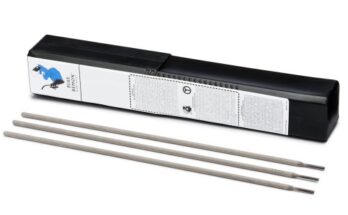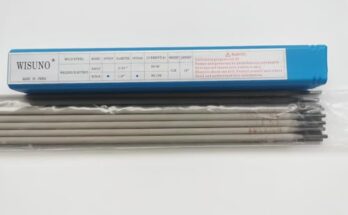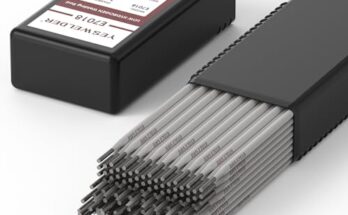Ever wondered what makes a strong weld? Understanding the right materials is key, and that’s where the 309L-16 welding rod comes in. This guide will help you understand its properties, applications, and everything you need to know about this crucial welding component.
Before diving into the specifics, let’s establish a foundational understanding
of what a 309L-16 welding rod actually is. It’s a type of consumable electrode used in the Gas Metal Arc Welding (GMAW) or Metal Inert Gas (MIG) process. This rod isn’t just any metal stick; it’s carefully engineered with a specific chemical composition designed for particular welding applications.
Chemical Composition and Properties
The “309L” in 309L-16 refers to its chemical composition, primarily consisting of austenitic stainless steel. This means it contains a high percentage of nickel and chromium, which are essential for corrosion resistance and high-temperature strength. The “L” denotes a low carbon content, which helps prevent carbide precipitation and enhances weld ductility. The “16” signifies its diameter in thousandths of an inch—in this case, 0.016 inches (0.4mm). This diameter is common for many welding applications, offering a good balance between weld penetration and deposition rate. Think of it like choosing the right brush size for painting—too small, and it takes forever; too large, and you lose control.
The unique chemical makeup contributes to its exceptional properties. It offers excellent corrosion resistance, similar to the parent metal it’s often used on—austenitic stainless steels like 304 and 316. This makes it ideal for applications where the weld needs to withstand harsh environments, such as marine or chemical processing industries. Additionally, its high tensile strength means the weld joint is exceptionally strong and durable. Imagine trying to break a weld made with 309L-16—it’s remarkably resistant to tearing or fracturing. This is crucial for applications where structural integrity is paramount.
Applications of 309L-16 Welding Rods
The versatility of 309L-16 makes it suitable for a wide array of applications. Its corrosion resistance and high-strength characteristics are highly valued in industries demanding superior weld quality. Common applications include the welding of dissimilar metals, particularly where joining austenitic stainless steels to other alloys is required. I’ve personally used it extensively in repairing equipment in food processing plants, where hygiene and longevity are critical. The weld must not only be strong but also resistant to the various cleaning agents used.
Another crucial application is in high-temperature environments. Because 309L-16 can withstand considerable heat, it’s often the preferred choice for welding components in furnaces, kilns, and other applications exposed to extreme temperatures. In one instance, I used it to repair a critical component in a high-temperature industrial oven—a task that would have been impossible with a less robust rod.
Comparing 309L-16 with Other Welding Rods
Choosing the right welding rod depends on the specific requirements of the project. While 309L-16 excels in many scenarios, understanding how it compares to other options is essential for informed decision-making. This section compares it with common alternatives.
309L-16 vs. 308L-16 Welding Rods
Both 309L-16 and 308L-16 are austenitic stainless steel welding rods, but their chemical compositions differ slightly. 308L-16 typically has a lower nickel content than 309L-16. This results in 308L-16 possessing slightly lower corrosion resistance and higher strength compared to 309L-16. The choice between them often hinges on the specific application; 308L-16 might be preferred where extreme strength is needed, while 309L-16 is favored in more corrosive environments. Consider the situation like selecting between two types of rope—one with greater strength, the other better able to withstand harsh weather.
The difference in nickel content significantly affects the weld’s microstructure. 309L-16, with its higher nickel content, exhibits a more stable austenitic structure, contributing to its enhanced corrosion resistance at elevated temperatures. This enhanced stability makes it ideal for long-term durability in challenging applications. Conversely, 308L-16, with its lower nickel content, might show slightly different microstructural characteristics that influence its mechanical properties.
309L-16 vs. ER308 Welding Rods
ER308 welding rods, also austenitic stainless steel, are a common choice in many welding operations. However, they differ from 309L-16 in terms of carbon content. ER308 often has a higher carbon content than 309L-16, making it susceptible to carbide precipitation at high temperatures. This can negatively impact the weld’s ductility and corrosion resistance over time. 309L-16’s low carbon content mitigates these risks, making it superior for applications demanding long-term performance in harsh conditions. Think of it as the difference between using regular steel and stainless steel for outdoor furniture—the latter resists rust much better.
While ER308 offers good weldability and strength, it may not be suitable for all applications where corrosion resistance is crucial. For example, in marine environments where the weld is constantly exposed to saltwater, 309L-16’s superior corrosion resistance is a significant advantage. This translates to reduced maintenance costs and a longer lifespan for the welded components.
Factors Influencing 309L-16 Welding Rod Selection
Selecting the right welding rod isn’t a one-size-fits-all decision. Various factors should be taken into account to ensure a successful weld. Understanding these factors empowers you to choose the optimal rod for the job.
Base Metal Compatibility
The base metal’s composition plays a critical role in choosing the appropriate welding rod. 309L-16 is designed primarily for austenitic stainless steels like 304 and 316. However, it can also be used to weld other materials. Always refer to the manufacturer’s specifications to ensure compatibility. Using the wrong rod can lead to porosity, cracking, or other weld defects. It’s like trying to mix oil and water—they simply don’t blend well.
Proper selection of the filler metal is crucial to ensure metallurgical compatibility with the base metal. Incompatible filler metals can lead to undesirable microstructures and reduced mechanical properties. This is especially important in high-stress applications where weld integrity is critical. In my experience, improper base metal compatibility has resulted in significant weld failure, requiring costly rework.
Welding Process Parameters
Different welding processes require different parameters. The 309L-16 rod is best suited for GMAW (MIG) welding. The parameters such as voltage, current, and wire feed speed must be optimized for optimal results. Improper settings can lead to inconsistent weld bead formation, poor penetration, and increased spatter. Optimizing the process parameters often requires trial and error and experience.
For example, using too high a voltage can lead to excessive weld penetration and possibly burn-through, while using too low a voltage can result in inadequate fusion. It’s a balancing act that depends on the thickness of the base material, the type of shielding gas used, and the welder’s skill level.
Welding Techniques and Best Practices
Proper welding techniques are essential for achieving strong and durable welds. This section provides some crucial tips for success when using 309L-16 welding rods.
Pre-Welding Preparation
Before initiating the welding process, it’s essential to prepare the base metal adequately. This includes cleaning the surface thoroughly to remove any contaminants such as grease, oil, rust, or paint. Contaminants can interfere with the weld formation, leading to defects. Think of it like preparing a canvas for painting—you wouldn’t want dirt interfering with the colors.
Proper cleaning involves using appropriate solvents, wire brushes, or grinding tools. The goal is to achieve a clean, bright metal surface to ensure proper weld fusion. This preparation stage is often overlooked, but it significantly impacts the weld quality and overall strength.
Shielding Gas Selection
The choice of shielding gas is another important aspect of successful welding with 309L-16. Argon, or a mixture of argon and helium, is typically used to shield the weld puddle from atmospheric contamination. The gas provides an inert atmosphere, preventing oxidation and ensuring proper weld formation.
The use of the correct shielding gas prevents the formation of undesirable oxides and nitrides in the weld metal. Inadequate shielding gas can result in porosity and weakening of the weld joint. Choosing the right gas blend is crucial for optimizing the weld’s metallurgical properties and overall performance.
Safety Precautions While Welding with 309L-16
Welding is an inherently dangerous process, requiring strict adherence to safety measures. This section outlines the essential precautions to ensure a safe welding environment.
Personal Protective Equipment (PPE)
Always wear appropriate PPE while welding, including a welding helmet with a suitable shade lens, welding gloves, and protective clothing. The intense heat and light generated during welding can cause serious eye and skin damage if not properly protected. Welding fumes can also be harmful to your respiratory system; therefore, a respirator or welding mask might be necessary, depending on the project’s scale.
Ignoring these safety measures can lead to severe burns, eye damage, respiratory problems, and other health hazards. It’s crucial to prioritize personal safety and follow all recommended safety guidelines.
Ventilation and Workspace
Ensure adequate ventilation in your welding workspace to remove welding fumes and gases. These fumes can be toxic and pose serious health risks. Working outdoors, or in a well-ventilated area, is recommended, especially when working with large-scale projects. Proper ventilation is essential for maintaining a safe and healthy welding environment.
Additionally, ensure your workspace is free of flammable materials, as the sparks and heat generated during welding can easily ignite combustibles. Keeping a fire extinguisher nearby is a sensible precaution, adding another layer of safety to your workflow.
Troubleshooting Common Welding Problems
Even experienced welders encounter problems occasionally. Understanding common issues and their solutions helps to avoid costly mistakes and improve welding skills.
Porosity and Inclusion
Porosity in welds refers to the presence of small gas bubbles. This weakens the weld and can reduce its corrosion resistance. It’s often caused by contamination of the base metal or improper shielding gas coverage. Solutions include meticulous cleaning of the base metal and ensuring adequate shielding gas flow.
Inclusions, on the other hand, are non-metallic materials trapped in the weld metal. They can reduce the weld’s strength and ductility. The causes can include using a dirty welding rod or insufficient cleaning of the base metal. Addressing these issues often involves pre-welding cleaning and using fresh, clean welding consumables.
Lack of Fusion
Lack of fusion is a serious defect where the weld doesn’t fully fuse with the base metal. This creates a weak point that can easily fail under stress. This often happens due to insufficient heat input, poor joint design, or contamination of the welding surfaces. Addressing this problem may require adjusting welding parameters, improving joint design, or meticulous cleaning of the weld surfaces.
Regular inspection of the welds during the process is essential for early detection and correction of any defects. Proper technique, consistent welding parameters, and meticulous surface preparation are crucial in minimizing the occurrence of lack of fusion.
Applications Across Diverse Industries
The versatile nature of 309L-16 makes it a crucial element in various industries. Its properties enable it to perform excellently in several challenging applications.
Chemical Processing
In chemical processing plants, where components are often exposed to corrosive chemicals, 309L-16’s high corrosion resistance is paramount. Its ability to withstand harsh chemical environments makes it ideal for constructing and repairing critical equipment in these plants, ensuring long-term operational efficiency and safety.
The use of 309L-16 in chemical processing reduces the risk of equipment failure due to corrosion, leading to increased safety and reduced downtime. The cost savings associated with its superior corrosion resistance often outweigh the initial cost of the rod itself.
Food and Beverage Industry
The food and beverage industry requires high levels of hygiene and cleanliness. 309L-16 is favored because it is highly resistant to corrosion and is easily cleaned. This makes it an excellent choice for welding equipment in food processing plants. Its ability to withstand regular sanitation procedures makes it ideal for maintaining sanitary conditions.
Moreover, the strength and durability of 309L-16 contribute to the long-term functionality of equipment, ensuring uninterrupted production and minimal disruptions.
The Future of 309L-16 Welding Rods and Advancements
The welding industry is constantly evolving, with continuous advancements in materials and techniques. This section explores the future trends and potential improvements related to 309L-16.
Improved Weldability
Research is continuously focused on improving the weldability of 309L-16, making it easier to use and reducing the likelihood of weld defects. Advancements in alloying elements and manufacturing processes are ongoing efforts to optimize its properties. These improvements will further enhance the efficiency and quality of welds.
The development of new fluxes and shielding gases could further enhance the weldability of 309L-16, reducing spatter and improving the overall appearance and quality of the weld. These continuous advancements benefit welders and the industries they serve.
Sustainability and Environmental Impact
Sustainability is an increasing concern in all industries. The production and use of welding consumables are being scrutinized for their environmental impact. Research is ongoing to develop more environmentally friendly materials and processes. This involves investigating lower-emission manufacturing techniques and alternative alloying elements.
Reducing the carbon footprint of welding rod production is a crucial area of focus. Investigating recycled materials and sustainable manufacturing practices are key steps toward a greener welding industry.
Frequently Asked Questions
What is 309L-16 welding rod best for?
309L-16 welding rod is best suited for welding austenitic stainless steels, particularly 304 and 316, and for applications requiring high corrosion resistance and high-temperature strength. It’s commonly used in industries like chemical processing and food and beverage manufacturing.
What are the advantages of using 309L-16?
Advantages include superior corrosion resistance, excellent high-temperature strength, good weldability (particularly with GMAW/MIG), and suitability for dissimilar metal welding. Learn more about its specific properties for a deeper understanding.
What are the potential disadvantages of 309L-16?
While versatile, 309L-16 can be more expensive than other welding rods. Incorrect application can result in issues like porosity or lack of fusion. Careful pre-weld preparation and proper welding technique are crucial for optimal performance.
How does 309L-16 compare to other stainless steel welding rods?
Compared to rods like 308L-16, 309L-16 typically offers superior corrosion resistance due to higher nickel content. Compared to ER308, its lower carbon content prevents carbide precipitation, enhancing ductility and long-term performance.
What safety precautions should I take when using 309L-16?
Always wear appropriate PPE, including a welding helmet, gloves, and protective clothing. Ensure adequate ventilation to remove welding fumes. Keep flammable materials away from the welding area. Learn more about welding safety best practices.
Where can I buy 309L-16 welding rods?
309L-16 welding rods are available from various welding supply distributors both online and in physical stores. Check local suppliers or search online for reputable vendors. Always verify the quality and authenticity of the product before purchase.
What type of shielding gas is best for 309L-16?
Argon, or an argon-helium mix, is typically recommended for 309L-16 welding to provide an inert atmosphere and prevent oxidation during the welding process.
Final Thoughts
The 309L-16 welding rod is a powerful tool in any welder’s arsenal. Its unique properties make it ideal for a variety of high-demand applications. By understanding its characteristics, proper application techniques, and safety precautions, you can leverage its strengths to create strong, durable, and corrosion-resistant welds. Remember that proper preparation, the right equipment, and a solid understanding of the welding process are key to success. So, whether you’re a seasoned professional or a curious beginner, mastering the use of 309L-16 will significantly enhance your welding capabilities. Take what you’ve learned here and start building your welding expertise!


